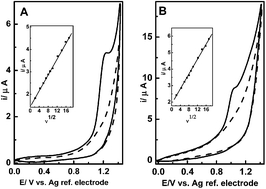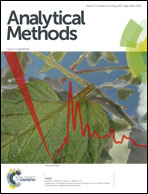Investigation of antimalarial drug pyrimethamine and its interaction with dsDNA by electrochemical and spectroscopic techniques
Abstract
The electrochemical behavior of the antimalarial drug pyrimethamine (PMT) was examined at a screen printed carbon electrode (SPCE) in different aqueous supporting electrolytes using cyclic voltammetry (CV) and differential pulse voltammetry (DPV). The oxidation process of PMT was found to be pH dependent and irreversible proceeding under the diffusion controlled mechanism. CV, DPV and UV/vis spectroscopy were employed to probe the interaction between PMT and salmon sperm double strand DNA (ss-dsDNA) under physiological conditions (pH 4.0 and 7.4). The binding constants between the PMT drug and DNA were calculated to be 5.4 × 105 M−1, 5.9 × 105 M−1 and 4.9 × 105 M−1 in pH 4.0 and 3.9 × 105 M−1, 4.1 × 105 M−1 and 3.3 × 105 M−1 in pH 7.4, using DPV and UV/vis spectroscopy, respectively. The diffusion coefficients were found to be 3.1 × 10−7 for PMT and 2.8 × 10−9 cm2 s−1 for PMT to DNA using the CV data. Based on the electrochemical and spectroscopic results, the binding of PMT–DNA was through a contribution of electrostatic interactions and/or hydrogen bonding along with intercalative binding. DPV determination of PMT at a SPCE surface modified with the ss-dsDNA layer was described. The method was applied for the determination of PMT in spiked serum.


 Please wait while we load your content...
Please wait while we load your content...